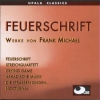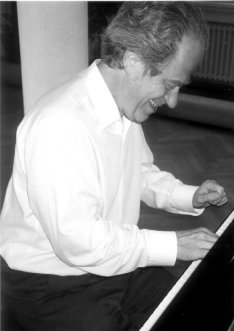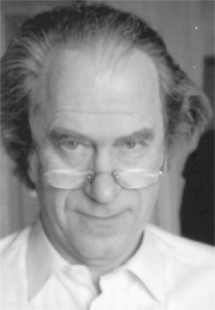FEUERSCHRIFT
 FEUERSCHRIFT
FEUERSCHRIFTWorks by Frank Michael
Track-List:
Feuerschrift op. 88 (1999) für Oboe, Violoncello und Klavier
1. 3:56
2. 3:56
3. 3:19
Streichquartett Nr. 6 op. 96 (2001/2002) "dona nobis pacem"
4. 3:33
5. 1:24
6. 1:21
7. 1:30
8. 1:46
9. 1:02
10. 1:42
Crying Game op. 77 (1996) für Saxophonquartett
11. 6:45
Arkadische Musik op. 85 (1999) für Bassetthorn und Streichtrio
Andante pastorale - Kanon I, allegretto pastorale - Scherzo / tempo di Valse - Notturno - Kanon II, allegro con fuoco / Coda pastorale
12. 4:05
13. 1:46
14. 2:30
15. 3:12
16. 3:19
Die Straßen singen, die Steine reden op. 76 (1995) "Hommage à Henry Miller" für Flöte, (Baß)Klarinette, Posaune, Violine, Violoncello, Kontrabaß und Klavier
26.12. 1891 im Labyrinth monotoner Straßen - Mezzotinto astrologico I - Ein Zwischenspiel - Rue de la Gaîté - Mezzotinto astrologico II - Insomnia - Coda "Il me semble, que les oiseaux sont ivres!"
17. 0:25
18. 3:01
19. 2:13
20. 4:47
21. 2:31
22. 2:03
23. 2:56
24. 0:58
Nocturnal op. 68 (1994) "Hommage à Anaïs Nin" für Flöte und Gitarre
25. 4:12
26. 2:44
27. 3:02
Introduction
 All the works on this CD were written in the 7 years between 1994 and 2001 as commission works; one work, Nocturnal, for the Ministry of Art Baden-Württemberg and another work, the 6th String Quartet, for the Music Publisher Zimmermann. Although all pieces are different and independent of each other, there are connections between them, similar to "work in progress". For example, the beginning of the middle section of Nocturnal and the beginning of the "Insomnia" section of "The streets sing…" are variations of each other. There are also quotations in all pieces, which - somewhat modified to suit my own style - relate to the theme of the work or refer to another work. The increased use of musical and number symbols since the 80's - a subcutaneous allusion, so to speak -, was complemented in 1995 through the use of horoscope series, melodic and harmonic serial arrangements, which were derived from Radice's "acting" persons and which are surprisingly ideal for characterising these persons. Even if the absoluteness of the music has increasingly surfaced since the "Arcadian Music", the hidden symbols retain their validity, as these symbols evolve nowadays almost as by-products. On the other hand, the works which seem to be defined primarily through symbols can always be also heard as absolute music. Because: it composes through me, in me. Igor Strawinsky, one of the more sober types in his guild, once said that: Sacre went through him, he "only" wrote it down. In one way, I can only confirm this for myself.
All the works on this CD were written in the 7 years between 1994 and 2001 as commission works; one work, Nocturnal, for the Ministry of Art Baden-Württemberg and another work, the 6th String Quartet, for the Music Publisher Zimmermann. Although all pieces are different and independent of each other, there are connections between them, similar to "work in progress". For example, the beginning of the middle section of Nocturnal and the beginning of the "Insomnia" section of "The streets sing…" are variations of each other. There are also quotations in all pieces, which - somewhat modified to suit my own style - relate to the theme of the work or refer to another work. The increased use of musical and number symbols since the 80's - a subcutaneous allusion, so to speak -, was complemented in 1995 through the use of horoscope series, melodic and harmonic serial arrangements, which were derived from Radice's "acting" persons and which are surprisingly ideal for characterising these persons. Even if the absoluteness of the music has increasingly surfaced since the "Arcadian Music", the hidden symbols retain their validity, as these symbols evolve nowadays almost as by-products. On the other hand, the works which seem to be defined primarily through symbols can always be also heard as absolute music. Because: it composes through me, in me. Igor Strawinsky, one of the more sober types in his guild, once said that: Sacre went through him, he "only" wrote it down. In one way, I can only confirm this for myself.All the works on this CD are concert recordings by the commissioners or the dedicatees, whom I would like to thank at this place for the wonderful hours of working together, for their lovely performances and for their permission to release these authentic live recordings here.
However: without Veronica Kraneis' courage and her untiring, intensive commitment, this CD would have remained only a sweet dream. To her, I would like to express my deepest gratitude.
Frank Michael
 Frank Michael was born on February 3rd 1943 in Leipzig, grew up in Marburg an der Lahn and studied composition (Richard Rudolf Klein, Kurt Hessenberg), flute (Willy Schmidt) and school music at the Staatliche Hochschule für Musik Frankfurt am Main. During this time, he also participated in the summer courses in Salzburg (Karlheinz Zöller) and at the Institut für Neue Musik (Institute for New Music) in Darmstadt.
Frank Michael was born on February 3rd 1943 in Leipzig, grew up in Marburg an der Lahn and studied composition (Richard Rudolf Klein, Kurt Hessenberg), flute (Willy Schmidt) and school music at the Staatliche Hochschule für Musik Frankfurt am Main. During this time, he also participated in the summer courses in Salzburg (Karlheinz Zöller) and at the Institut für Neue Musik (Institute for New Music) in Darmstadt.Between 1984 and 1994, he was lecturer for composition/harmony at the Musikhochschule Frankfurt, later also for contemporary music and music style/music analysis at the Musikhochschule Mannheim/Heidelberg. In 1990/1 and 1994, he also taught young composition students at "Schüler komponieren - Treffen junger Komponisten" for the "Jeunesses musicales Germany" at Schloss Weikersheim.
Frank Michael was initiator of several concert series for contemporary music, such as the "Marburger Studio" and the "Neue Reihe - Music of the 20th Century" in Freiburg. Since 1971 he has been a member of the ensemble "Camerata Instrumentale Freiburg". 1985 after the death of Sigrid Eppinger he became leader of this ensemble. He is also organiser of the serenade concerts at the historic "Kaufhaus".
From 1971 to 1974, he was a scholarship recipient of the "Mozart Stiftung von 1838 der Stadt Frankfurt a. M". In 1975 he won the merit award of the Johann-Wenzel-Stamitz-Preis, in 1976 the merit award of the City of Stuttgart and in 1984 the merit award of the Reinhold-Schneider-Preis Freiburg.
The compositions of Frank Michael are characterised by a great will to express, which resulted in the expansion of instrumental techniques (especially in the years between 1970-1984) and the use of additional cipher layers (quotations, musical and numerical symbolism). Poetic and constructive elements surface very strongly in his works; elementary themes such as death, eroticism and nature play - often encoded - an important role in his compositions.
Frank Michael is a freelance musician and currently resides near Freiburg.
Feuerschrift (Fire Script)
Music for oboe, violoncello and piano
op. 88
My piece for oboe, violoncello and piano op. 88 "Feuerschrift" (Fire Script) was written in 1999 for the Trio pianOVo and was also dedicated to this ensemble. Long after the composition was finished, there was still no title for the piece. There was "only" music - and in some places also music on music: with a minimal transformation of the main motif in the middle of the first section, a fantasy sketch of the beginning of the second movement of Beethoven's Second Symphony is integrated into the music. Variations of the Faust motif from the Faust Symphony by Liszt are hidden in all the movements. Of course, this has to do with the fact that the music was written for Weimar…..
String Quartet No. 6 "dona nobis pacem" op. 96
The sixth string quartet was written between December 11th 2001 and January 4th 2002 under the impressions of terror and war. "Dona nobis pacem" - actually not so much a prayer to God - naturally also to God - but rather an appeal to all people. Give yourselves Peace! Of course, this is only an Utopian dream, as visionary as the thought that one can achieve peace through such an artwork. And yet, one can only counteract terror and war with culture, a culture which must be filled with sympathy and tolerance. So the quartet has 180 bars - as 18 (twice 9) is a holy number in all religions: Judaism, Christianity, Islam, and also Hinduism and Buddhism. The title of the work gives the number 576, in which the number 24 is contained twice (24x24=576). The number that represents totality, which is also the number of letters of Greek alphabets and of musical notes. Music as sonorous number, as a reference to spherical harmony.
I have always been touched by "Agnus Dei" in Beethoven's Missa solemis, especially the a-capella prayer for peace. This motif, in various guises and more or less veiled, passes through the whole quartet, a fantasy on the motif. The counterpart is the Renaissance song "L'homme armé" which is parodied in so many Masses (!). And at the end, Beethoven's "dona nobis pacem" is united with the main motif of the Missa da Pacem by Josquin Desprez.
Crying Game op. 77
Crying Game: a contradiction in itself, a paradox like life. Already the title: how do screaming, weeping and a game come together? This happens in the erotic thriller "The Crying Game" by Neil Jordan: tenderness and affection besides brutal and shocking consequences in action; a life consisting of light and shadow, personified in beautiful, fascinating androgyne Dil.
The work is an homage to a very impressive film, but also an homage to the saxophone, which can express sensuality, eroticism, tenderness besides brutality, melancholy and grief like no other instrument could do.
Crying Game was written in 1996 as a commission work for the saxophone performers Thomas Sälzle, Dieter Kraus, Guntram Bumiller and Stefan Eger, and was dedicated to them.
Arcadian Music op. 85
I have long been fascinated by the pastoral character of the basset horn. The music, which first did not have a title, was therefore named "Arcadian Music" which resulted in a passage from Jacques Offenbach's "Orpheus in the Underworld", namely "When I was still prince in Arcadia...", being quoted freely in the last section of the piece. There are also more hidden half-quotes in the work such as the pastoral beginning of the wonderful bucolic opera "Daphne" by Richard Strauss, a work, where the basset horn also plays an important role.
The work is dedicated to Martin Litschgi.
The streets sing, the stones speak op. 76
"The streets sing, the stones speak" is an homage to Henry Miller. The starting-point: his biography, mainly that of the early years in New York and Paris. The tone materials are derived from the birth horoscopes and compositions of Miller and his wife June and from Anais Nin. A glittering artist life; bubbling over; enthusiastic; at times vegetating away in misery and hunger; despairing in distress; clownish; gargantuan; an American in Paris; full of love, anarchy and hate; romantic; and full of wisdom with all its contradictions. An artist, who sang of love, sexuality and life; a life, which ended on the 7th of June 1980 at 16.30 hours, released into light after 32304 days on earth. "Il me semble, que les oiseaux sont ivres".
Nocturnal op. 68
Although "Nocturnal" can also be heard as absolute music, there are additional dimensions to the piece. As an homage to Anais Nin, musical and numerical symbols play an important role in the work, e.g. especially in bar 217 where the notes of Anais Nin and Henry Miller - A-ais (A and A-sharp) and H-Mi (B and E) - are intertwiningly played as a double tone by the flute and as a glissando by the guitar, and where the number 217 also symbolises the phrase "Hommage à Anais N. und (and) Henry M.". The authors A. N. and H. M. inspired each other, especially at the beginning of the thirties while they were in passionate love. Considering this, even the opus number has a hidden meaning: 68 = Lust (desire, pleasure) = ANHM + Paar (pair) (= 34 + 34). Naturally, the metronome markings (e.g. 42 = Anais) also have symbolic meanings.
The title "Nocturnal" - in contrast to the more lively "notturno" or the more dreamy "nocturne" - was chosen to depict also the abysmal dimensions of the night music. "Nocturnal" is also the title of the last work of Edgar Varèse, which was inspired by the text fragments of "House of Incest" (1924) by Anais Nin. From this work, one passage is freely quoted.
"Nocturnal" was commissioned by the Land of Baden-Württemberg (Ministry of Art).
Back to the list